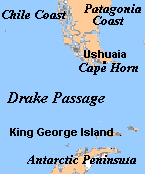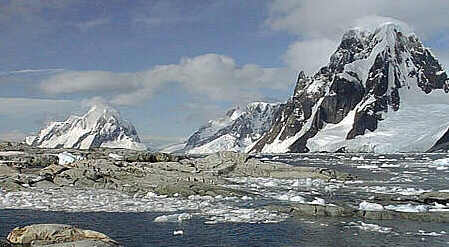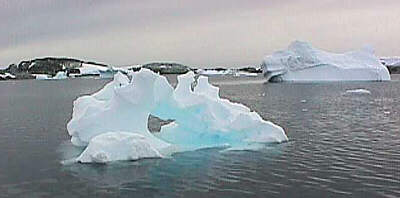 |
|
 click map for more detailed location info |

Report 9 February - Team B on board Pelagic
Tues 9th FebIt was not a writers' block. That would have been a poor excuse anyway, but yesterday I just could not write about what I had seen. After dinner I sat down behind the computer screen, still impressed by the amazing natural beauty that had passed our eyes. I felt restless down in the galley and I was ill at ease with all the disturbing noises around me. The jingling and tingling of pots and pans, the voices and the music. All the things I normally find pleasant to hear while writing, now I could hardly stand. I tried to write a few lines, but erased them immediately. They were all cliches, nothing seemed to be appropriate. In the end I gave up.
I stopped my struggle with words and went up on deck. It was midnight but the sun still gave light from behind the hills around Paradise Harbour. You could see dusk slowly growing, colouring the sky with soft shades of lilac. Standing at the bow of Pelagic, I could hear nothing but the soft murmur of little waterfalls originating from melting ice on the glaciers around us.
I have never experienced a silence like this before. It is not just the silence around you that is impressive. This you feel inside, in your heart, your veins, your whole being. Whenever I see a church or cathedral that is open, I go in. I don't go for sermons or mass. It is the silence that I love in churches. In these days silence more and more becomes a rarity in the western world. In Holland I can hardly name a spot where you do not hear cars, aeroplanes or the never ending noise of building machines. We always need more motorways, more houses, more offices, more of everything. Not even the thick walls of churches can keep out the noise we produce anymore.
Although no ancient architect has ever been in the Antarctic, here you find the inspiration for all churches and cathedrals. Nature itself forms a huge icy cathedral with glittering towers in snow white and blue. Here silence is normal and it will largely be maintained as long as seals, whales and penguins run the show.
At dawn we saw ourselves stuck in the ice. Although we are on the sea and it is salt water around Pelagic, the water had frozen. But, with the rising sun, the ice started melting and because this boat is made for these regions we could easily glide through the crispy ice out of Paradise harbour. During the whole day the hull of the boat had cracking encounters.
 |
We sailed through waters full of 'bits and pieces', ranging from icecubes that would neatly fit into a glass of whisky to floating ice castles. Today's route included Gerlaiche Strait and Lemaire Channel. Another day of sunshine and stunning views. Lemaire channel is often called the "Kodak Passage" because you simply must take photographs when sailing here. Luckily some 'new' animals popped up: leopard seals with sweet wet eyes, who look like you can hug them and Minke whales, swimming at high speed, competing with our engine.
Yesterday, Eric started taking pictures of a series of glaciers and coastal points. Today he continued this job. Troy monitors how far the ice shelves stretch, recording our exact position co-ordinates when taking the pictures. In the coming years all these places will be visited by other Mission Antarctica teams who will use the data we are now gathering. They will take pictures from exactly the same spots to see what changes have taken place. In this way we hope to help monitor possible effects of global climate change. Global warming might lead to the melting of the polar iceshelves and a rise of the sea level.this would have disastrous affects on the lives of millions of people living near coastlines.
So far we have spoken to several scientists (on King George Island) who say they witnessed considerable changes in ice coverage in their working area in the last decade. On King George Island they even found plants, similar to corn, that normally wouldn't grow in these regions because of low temperatures. Our aim is to illustrate this change by collecting this data.
Now we are going for a late visit to the Ukrainian Base Vernadsky. We are anchored in their bay. The base was British until 1996 when they handed it over to the Ukrainians. Tomorrow you will hear more about it.
Kirsten Kuipers
| Weather and Position Data | |||
| 1. Date | 2. Time | 3. Posn Lat | 4. Posn Long |
| 09/02 | 15.05 local | 65°-01.45S | 63°-41.47W |
| 5. Compass Heading | 6. Wind Speed | 7. Boat speed | 8. Wind Dir |
| 241° | 10 Knots | 2 Knots | 20° |
| 9. Pressure | 10. Air Temp | 11. Sea Temp | 12. Cloud Type |
| 994 | +8°C | no data | cirrus, alto cumulus |
| 13. Cloud cover | 14. Precipitation | 15. Sea State | 16.Comments |
| 95% | none | Flat calm | |